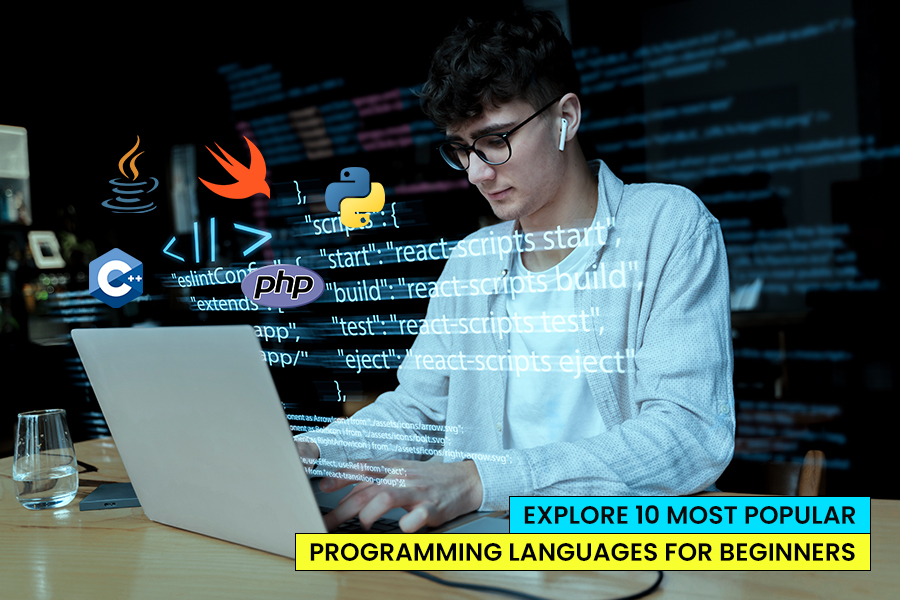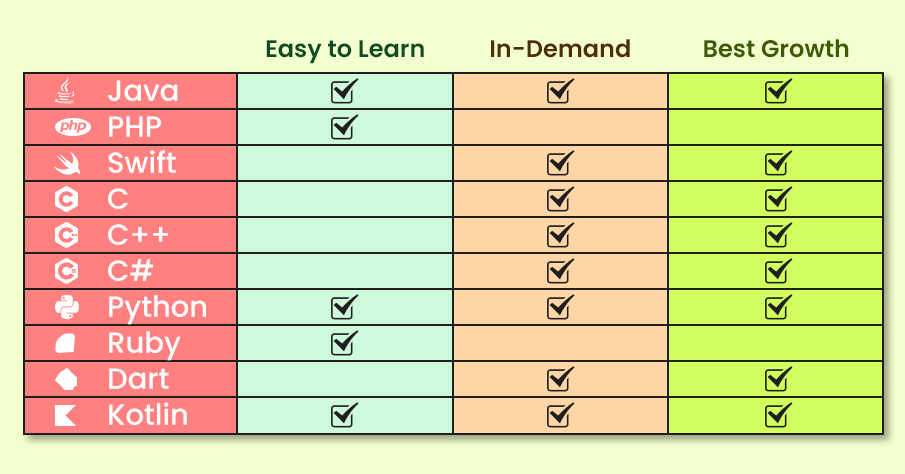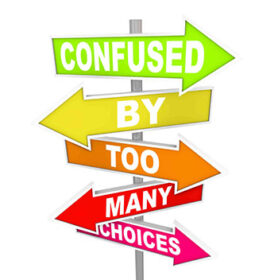
Gone are the days when joining the IT domain was a struggle. Today, you require programming skills to become a part of the digital realm.
Programming skills are invaluable in this technologically advanced era. They kickstart your career in the IT domain, sharpen your technological skills, and let you build an innovative digital presence. Learning programming languages diligently help all candidates, both beginners and IT-seasoned individuals.
Which are the best programming languages for beginners to learn?
It is never too late to master programming languages. Numerous courses are available, from Python to PHP. Choosing the best programming languages is essential for career growth and advanced market opportunities.
This comprehensive blog explores the 10 most popular and beginner-friendly programming languages to learn. We will elaborate on the benefits of each course and its suitability for beginners in the IT domain.
Understanding Programming Languages for Beginners
Programming languages are instructions written for the computer to understand, follow and accomplish. Since a laptop only speaks in binary, in 0s and 1s, programming languages were developed to communicate and instruct.
Multiple programming languages exist, each with unique abilities and used for specific tasks. Web developers use programming languages to create applications, websites, and software programs.
A few popular programming languages are C, C++, Java, JavaScript, Python, etc. Each language is unique and has its specialities. Some of these languages are beginner-friendly and help progress in the digital landscape.
Why are programming languages vital?
The programming languages are the backbone of this evolving digital landscape. Every mobile application and website we browse is developed with these languages. The languages play a pivotal role in this era –
- They are essential to creating numerous web presences – from e-commerce to social media platforms. The languages help make websites functional and user-friendly.
- Additionally, these languages are the core of all messaging and communication applications. They facilitate seamless communication.
- The programming languages help automate tedious tasks effortlessly. They are the core functionality behind the day-to-day smart devices and save precious time.
Every digital smart innovation that eases our daily lives is developed using a popular programming language. Both beginners and seasoned developers must brush up their programming skills to ensure the digital aspects are user-focused and functional.
Which Programming Language is best for Beginners? – Factors to Consider
Now that you have decided to gain programming skills, let’s discuss some of them. Coding for beginners can be simple. The knowledge base must be strong, relevant, and cater to the evolving domain’s needs.
Here are some factors to consider when opting for a programming language to learn –
Ease of Learning –
As a beginner in coding, pick the easiest programming languages, especially at the initial stages. An easy-to-learn programming language enhances the learning experience, boosts confidence and contributes to the zeal to learn more. Choose an easy yet popular programming language with a high usability factor.
Application Scope –
It is crucial to pick a programming language with a broad application scope. For instance, imagine spending months learning a new programming language to learn it can develop websites but not applications. So, make a wise choice when selecting the language. Invest ample time in understanding the language and its capabilities. Additionally, align the scope with your learning objectives to find the ideal match.
Community Strength –
A flourishing developer’s community helps newcomers overcome major language complications while in a learning phase. Having a community is impressive – it is a constant support in this evolving sector. The community contributes to the growth of the programming language and keeps related learners aligned with the growing trends.
Choose a programming language with a thriving community with contribution ability.
Sufficient Opportunities –
The primary purpose of enrolling in a programming language course is to gain traction in the market and gain a desirable job. The popularity of the language will determine the chances of getting hired.
Several job-hunting websites like Indeed and LinkedIn highlight the most popular languages such as Java, JavaScript, C##, etc. Choose wisely among the most desirable ones with the scope of better job opportunities and future growth.
Plenty of factors help analyse the available programming languages and determine the best ones to learn. Candidates can experience steady career growth and opportunities with a suitable knowledge base. If you need help making a choice, we advise consulting industry-leading mentors.

The 10 Best Programming Languages to Learn in 2024
We have discussed the importance of programming languages and factors to consider when selecting one. Let us delve into the easiest coding languages that are perfect to kickstart a career in the digital realm. We will explore the features of each language and whether they are a promising choice for beginners.
1. C – A Classic Starting Point
C is a foundational programming language developed by Dennis Ritchie in the 1970s. Today, it remains one of the most widely used programming languages.
C functions as the basis for many other languages and operating systems. It is a crucial language to learn for aspiring programmers.
Features of C –
C is a simple yet efficient programming language—its defining quality. It is a low-level language that provides direct access to system resources and hardware. C is ideal for tasks that require high performance and tight control over system resources.
It is a procedural language; it follows a step-by-step approach to execute instructions. Procedural languages are easy to understand, making it a perfect choice for beginners.
Additionally, C offers a rich set of built-in functions and libraries that provide powerful tools for developers. It supports modular programming, where complex tasks are broken down into smaller, more manageable modules. Each module can be reused in other parts of the program.
Why C is Suitable for Beginners?
Learning C as a beginner aids in a solid foundation in programming fundamentals such as variables, data types, loops, and conditional statements. These concepts are transferable to other programming languages, making it easier for beginners to transition to more advanced languages.
In a C programming language course, beginners can develop a strong understanding of computer architecture and system-level programming. This helps them develop complex websites and application interfaces.
Numerous resources are available online for beginners looking to learn C. One of the best is Webskitters Academy, which offers comprehensive courses on C programming for beginners. It covers everything from basic syntax to advanced concepts that aid development.
By taking advantage of available resources, beginners master C programming and build their projects quickly.
2. Java – Versatile and Widely Used
Launched in the 1990s by Sun Microsystems, Java is an object-oriented programming language. It is a high-level, platform-independent language that runs on any device with a Java Virtual Machine (JVM) installed. Java’s syntax is similar to C++, making it relatively easy for beginners to learn.
Advantages of Learning Java for a Beginner –
There are multiple advantages to learning Java as a beginner. Let us explore a few –
- Java is a large and active community of developers. These experts contribute to the plenty of resources and support available for beginners.
- It is widely used across industries, including web development, mobile app development, enterprise software, and scientific applications. The versatility opens up a wide range of career opportunities for Java beginners.
- The object-oriented nature of the language encourages good programming practices such as code reusability, modularity, and maintainability. These are essential skills for any programmer to learn.
- The powerful typing system helps beginners catch errors at compile time, making debugging and code maintenance easier.
Applications of Java in Real-World Scenarios –
The Java programming language is utilised in a multitude of real-world scenarios. Here are a few Java used cases –
- Java is used to build dynamic websites and web applications. Other popular frameworks, like Spring and Hibernate, are based on Java.
- It is the central programming language for developing Android applications.
- Java helps develop scalable and robust backend systems for enterprise software.
- The language’s performance and portability make it ideal for scientific computing and data analysis tasks.
Recommended Learning Resources for Java Beginners
Numerous resources are available online and offline for beginners looking to learn Java. Course websites are a great place to start and gather measurable skills. Several free online tutorials cover everything—from basic syntax to advanced topics in Java programming.
3. PHP – Powering the Web
PHP, or Personal Home Page, is a server-side scripting language for web development. It was launched by Rasmus Lerdorf, a Danish-Canadian programmer, in 1994. Since then, PHP has evolved into a powerful tool for building dynamic websites and web applications. The code is executed on the server, generating HTML content that is then sent to the client’s web browser.
Significance of PHP for Beginners in Web Development
PHP is immensely significant to beginners joining the web development realm. Unlike client-side languages like HTML and CSS, PHP allows developers to create interactive and dynamic web pages by generating content on the server. It makes PHP an essential language for building websites with features such as user authentication, form processing, database integration, and content management systems.
PHP’s primary advantage is its shallow learning curve. Its syntax is similar to C and is accessible to learners with prior programming experience.
Additionally, PHP allows flexibility in coding style and does not demand strict adherence to best practices. These features make it easier for beginners to experiment and learn.
Here are a few features to explore and understand –
- PHP code is HTML embedded; mixing programming logic with markup is easy.
- The manual provides comprehensive documentation and examples for each function and feature. The documentation is a valuable resource for beginners.
- The language comes with built-in functions and libraries for everyday tasks. It can manage file handling, database access, and string manipulation, reducing the need for beginners to write complex code from scratch.
Courses for Learning PHP –
Numerous online tutorials and courses are available for beginners planning to learn PHP. These interactive courses cover basic syntax and concepts and help beginners transition to advanced levels.
The official PHP website also provides tutorials, documentation, and a community forum for PHP developers of all skill levels. YouTube also covers various aspects of PHP programming Course, from basic concepts to advanced topics.
Online communities and forums are an impressive shared space to seek advice, share knowledge, and connect with other learners and experts.
4. Swift – Entry into iOS Development
Apple developed the programming language Swift, which is powerful and intuitive. It was designed in 2014 to be modern, safe, and easy to learn. The language is primarily used for developing Apple platform applications, including iOS, Mac OS, Watch OS, and more.
Swift in iOS App Development –
Swift is a crucial programming language in app development. iOS App Development with Swift helps build applications for Apple mobile platforms. The language has several advantages over its predecessor in terms of performance, safety features, and a streamlined syntax.
Swift is fully interoperable with Objective-C. It allows developers to integrate Swift code with previous Objective-C codebases seamlessly.
Beginner-Friendly Features of Swift –
Swift was created with beginners in mind and offers several features that make it easy to learn and use –
- The syntax is concise and expressive, making it easier for beginners to write and understand code.
- The language employs a powerful type system to catch errors at compile time. It reduces runtime crashes and bugs.
- The Automatic Reference Counting (ARC) manages memory automatically. It eliminates the need for manual memory management and reduces potential memory leaks.
- Swift Playgrounds is an interactive environment for beginners to write and test code in real-time. Beginners can experiment and learn during the course phase.
Tips for Learning Swift Effectively as a Beginner
If you are planning to learn Swift effectively as a beginner, here are a few tips and strategies to consider –
- Learn the fundamentals of Swift diligently, including variables, data types, control flow, and functions.
- Practice writing code regularly to reinforce your understanding of concepts and syntax.
- Apply the knowledge by building small projects. Start with simple IOS projects and gradually increase the complexity.
- Leverage online tutorials, courses, and documentation to supplement your learning. There is no harm in seeking help from beginners.
- Actively become a part of online communities and forums to ask questions, share knowledge, and connect with other Swift developers.
These tips and dedicated time and effort to learning Swift are sufficient for beginners to become proficient iOS developers and get hired by reputable organisations.
5. C++ – Building Blocks of Complex Systems
Bjarne Stroustrup developed C++ in the early 1980s as an extension of the C programming language. It is a powerful and versatile language that adds object-oriented programming features to C while maintaining compatibility.
The programming language is used to develop a wide range of applications, including system software, game development, embedded systems, and high-performance applications.
Differences between C and C++ –
While C and C++ share numerous features and functionalities, there are some critical differences between the two –
- – C++ introduces classes and objects in coding. It allows developers to organise code into reusable modules based on properties and behaviours.
C, on the other hand, is a procedural language without OOP support.
- – C++ provides features like inheritance, polymorphism, and encapsulation. The features allow better code organisation and abstraction of complex systems.
C needs these features and is more suitable for building large-scale software systems.
- C++ entails an extensive library, the Standard Template Library (STL), which provides a collection of generic algorithms and data structures. Compared to C, it is easier for developers to write and maintain code in C++.
Applications of C++ in Various Fields –
C++ is widely used in various industries and applications, including –
- Game development engines like Unreal Engine and Unity are written in C++.
- System software includes operating systems, network protocols, and device drivers.
- Embedded Systems for microcontrollers, automotive systems, and IOT devices.
Numerous beginner-friendly books, tutorials, and online courses are available to help you master C++ and enter the web development realm. These courses provide comprehensive tutorials and documentation to learn from scratch and are mentored by industry experts.
Additionally, practice platforms offer coding challenges and exercises for beginners to sharpen their C++ skills and gain hands-on experience.
6. C# – Microsoft’s Versatile Language
C# or C sharp is an object-oriented and modern programming language. Microsoft developed it in the early 2000s as part of the .NET framework.
C# is simple, powerful, and versatile, with syntax similar to C, C++ and Java. It is used for developing desktop, web, and mobile applications, games, cloud services, and enterprise software.
Advantages of Choosing C# as a Beginner –
If you are opting for C# as your core programming language skills, you have numerous benefits to experience –
- C# has a simplified syntax and a rich set of libraries and tools. It is relatively easy for beginners to catch up and start programming.
- It is a strongly typed language, and the variables are declared explicitly with data types. It catches errors at compile time and makes the code robust and manageable.
- It is an object-oriented language that encourages good programming practices such as code reusability, modularity, and encapsulation. Beginners can learn fundamental concepts of object-oriented programming (OOP) while working with C#.
- It is a versatile programming language utilised for a range of applications. Beginners can explore different areas of software development and find their niche.
Applications of C# in the Software Development Domain
C# is a popular OOP language and is utilised in various fields of software development –
- It is commonly used for building desktop applications using frameworks like Windows Presentation Foundation and Forms.
- It can be used for server-side web development with technologies like ASP.NET Core and ASP.NET MVC and client-side scripting with frameworks like Blazor.
- It is used in game development with popular Unity and Unreal Engine engines. The powerful features help work with complex graphics, physics, and AI.
- It helps in cross-platform mobile app development, where code is written once and deployed on multiple platforms.
The internet provides numerous beginner-friendly C# courses taught by experienced mentors. Microsoft’s official documentation and tutorials are comprehensive resources for beginners to learn the language and its features.
As a learner, start with small projects and gradually increase the complexity to improve your problem-solving skills. The language provides excellent opportunities for beginners to enter programming and develop exciting solutions.
7. Python – Beginner’s Delight
Python is a high-level and interpreted programming language. It is a simple and readable language developed by Guido van Rossum in the late 1980s. Since then, Python has become one of the most popular programming languages.
Why Python for Beginners?
Python is considered one of the best and most accessible programming languages for beginners due to several reasons –
- The syntax is simple and closely resembles human language, making it easy to understand and learn.
- It is a multipurpose language suitable for various applications, including web development, data analysis, artificial intelligence, automation, etc.
- There are abundant tutorials, documentation, and online courses for learning Python, making it accessible to beginners.
- It has a large and active community of developers willing to help and support beginners. You can explore forums, online communities, and social media platforms.
- The comprehensive standard library provides modules and functions for performing various tasks without additional installations.
Applications of Python in Various Fields
Python has many applicable fields, making it a desirable programming language skill. Here are a few examples –
- Frameworks like Django facilitate the rapid development of web applications using Python.
- The simplicity and extensive libraries make it a preferred choice for data analysis, visualisation, and machine learning tasks.
- The ease of use and cross-platform compatibility make it an excellent choice for automating repetitive tasks.
- Python helps develop simple games and prototypes along with the Pygame library.
- The language is used in scientific computing for simulations, modelling, and visualisation.
Numerous websites and academies offer interactive Python courses suitable for beginners. These are designed to help people transition from beginner to advanced level with the right skills. Industry professionals instruct the available classes.
With its applicability across various industries, Python offers an excellent entry point for beginners in programming.
8. Ruby – Elegant and Beginner-Friendly
Ruby was created in the mid-1990s by Yukihiro Matsumoto. It is a dynamic, object-oriented programming language with a simple and elegant code structure. The syntax is naturally designed and intuitive, resembling spoken English. It contributes to its ease of use and readability.
Beginner-friendly Features of Ruby
Ruby offers several features and functionalities that make it particularly suitable for beginners –
- The syntax is clean, concise, and easy to understand, making the language accessible to both beginners and experienced programmers.
- It is dynamically typed, meaning the variables must not be explicitly declared with their data types. The flexibility reduces the cognitive load on beginners and allows faster development.
- Ruby focuses on objects, including numbers, strings, and even classes. This object-oriented nature encourages positive programming practices and provides a consistent and intuitive programming model.
- The language has a rich standard library with many built-in methods and classes for everyday tasks. The built-in abilities reduce the struggle of working from scratch.
Ruby and Web Development
Ruby is widely utilised in web development with the Ruby on Rails framework. The ease of use of syntax makes it an ideal choice for beginner-level web developers. Here are some applications of Ruby in web development –
- Ruby on Rails is a popular web framework for building dynamic and database-driven web applications. The principles of Convention over Configuration (CoC) and Don’t Repeat Yourself (DRY) streamline development processes and encourage best practices.
- It is used to build RESTful APIs (Application Programming Interfaces) to serve data and functionality to other applications.
- Many e-commerce platforms and marketplaces, like Shopify, are built using Ruby on Rails. The programming language ensures scalability, flexibility, and rapid development capabilities.
The official Ruby documentation provides comprehensive guides, in-depth tutorials, and references for beginners looking for Ruby resources.
Additionally, numerous websites offer job-guaranteed courses on Ruby and Ruby on Rails. In a learning program, leverage forums and communities to ask questions, seek advice, and connect with other Ruby developers.
9. Dart – Google’s Language for UIs
Dart is an object-oriented C-style programming language developed by Google. Since its inception, it has gained immense popularity and has made quite a name for itself in web and mobile app development.
The language is simple and productive, and the compiled nature creates fast and efficient applications. Dart is used with the Flutter framework to build user interfaces across multiple platforms.
Dart in Developing User Interfaces
Dart integrates with the Flutter framework to significantly influence user interface development. It is Google’s UI tool for developing mobile, web, and desktop applications using a single codebase.
Dart is the primary programming language for Flutter. It provides developers with a productive and expressive language for creating beautiful, high-performing user interfaces.
Beginner-Friendly Features of Dart
Dart has numerous features and functionalities that make it a perfect programming language for beginners to master. Take a look at the comprehensive features of the language –
- The syntax is easy to understand and resembles other mainstream programming languages like JavaScript and Java. This feature makes it accessible to beginners.
- It is a statically typed language, meaning variables are explicitly typed. The variables are manually typed during compilation, which is seamless for culling out code errors and enhancing reliability.
- The hot reload feature by Dart and Flutter allows developers to see changes to their code instantly. The modifications are immediately reflected in the app UI during development. The rapid feedback loop speeds up the development process and enhances productivity. Learn Flutter with Dart App Development.
- The official documentation for the language is comprehensive and beginner-friendly. It provides tutorials and guides which help beginners get started with the language.
Getting Started with Dart –
Before enrolling in a comprehensive Dart course, investing time to explore the language is acceptable. We have provided some detailed steps to start learning Dart –
- Download and install the Dart SDK from the official Dart website.
- Dart is compatible with various text editors and integrated development environments. Choose an editor that suits your preferences and install the Dart plugin.
- Start by learning the basics of Dart, including variables, data types, control structures, functions, and classes. The official Dart documentation provides tutorials and guides for beginners.
- Once comfortable with Dart, explore the Flutter framework for building user interfaces. You can find extensive documentation, tutorials, and samples to help you get started.
To reinforce learning, Practice writing Dart code and building simple Flutter applications. Start with small projects and gradually increase the learning curve.
You can always benefit from taking a course with seasoned mentors. They are aware of the real-life application of Dart and can help you network, which are necessary skills to thrive in the employment field.
10. Kotlin – Modern Android Development
Kotlin is a statically typed programming language introduced by JetBrains. It is fully interoperable with Java and addresses its deficiencies.
Kotlin has a concise syntax and null safety features and supports functional programming concepts. In 2017, Google announced Kotlin as the official language for Android app development, further solidifying its position in the software development landscape.
Advantages of Learning Kotlin for Beginners
If opting for Kotlin programming, learning about the plethora of advantages is essential. Let us delve into them –
- Kotlin has a concise syntax and helps developers write cleaner and more readable code than Java.
- The type system prevents null pointer exceptions by distinguishing null and non-null types, reducing the risk of runtime crashes.
- Full interoperability with Java allows the use of existing Java libraries and frameworks in Kotlin projects and vice versa.
- The language incorporates modern features such as lambdas, co-routines, extension functions, and data classes. These features enable developers to write code efficiently and maintain effortlessly.
Numerous resources and tutorials are available for beginners looking to learn Kotlin. The official Kotlin documentation provides comprehensive guides and references for learning Kotlin from scratch.
Tips for Transitioning from Java to Kotlin
If you are a seasoned Java developer opting to transition to Kotlin, here are some tips to get started –
- Familiarise yourself with Kotlin syntax and language features, such as null types, data classes, and extension functions.
- Take advantage of the extension functions and properties to enhance existing Java codebases and make them more conversational.
- Migrate Java codebases to Kotlin by converting individual classes or modules one at a time.
- Practice writing Kotlin code and experiment with different language features to gain proficiency and confidence.
- Use the interoperability feature to code seamlessly into existing Java projects and vice versa.
Mastering Kotlin will make candidates highly marketable for the job and introduce numerous opportunities in Android development. Always consult professionals when struggling to decide which programming to choose and whether or not to join a comprehensive course.
Enrolling in the Best Programming Language Course to Learn Advanced Development
With rigorous evolutions in the digital domain, whether you are a beginner or a practising developer, it is essential to stay aligned with programming language trends. The programming languages, especially the ones we discussed, are core development essentials and ensure the quality of web applications.
Before enrolling in any of these, thoroughly understand the purpose of each language, its benefits and whether it applies to your career graph. Additionally, understand the demand of each and how it can impact your career trajectory.
At Webskitters Academy, we help candidates make the right choice when kickstarting their careers in the digital domain. We offer Kolkata and Durgapur’s best programming language courses and focus on imparting structured learning programmes. Learn under industry-leading mentors and gain from our certified, job-guaranteed curriculum.
Search
I Want to Learn...
Category
Explore OurAll CoursesTransform Your Dreams
into Reality
Subscribe to Our Newsletter
"*" indicates required fields
 New Year Special Discount Offer - Upto 20% Off on all Course Fees - 43 Seats Available
New Year Special Discount Offer - Upto 20% Off on all Course Fees - 43 Seats Available 







